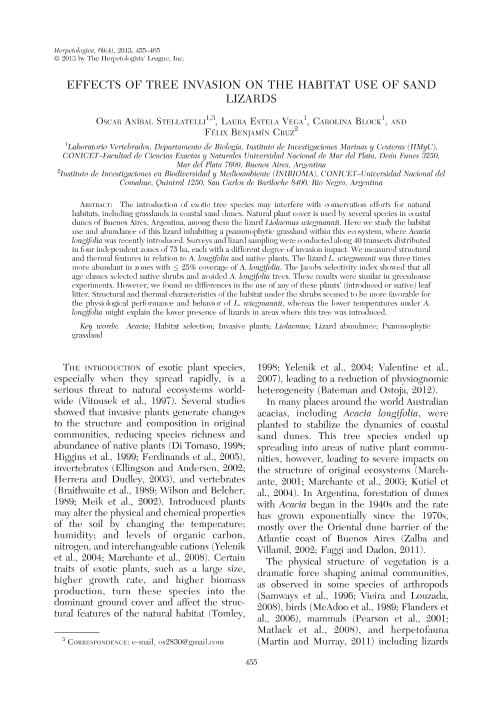Artículo
Effect of the tree invasion on the habitat use of sand lizard
Fecha de publicación:
11/2013
Editorial:
Herpetologists League
Revista:
Herpetologica
ISSN:
0018-0831
Idioma:
Inglés
Tipo de recurso:
Artículo publicado
Clasificación temática:
Resumen
The introduction of exotic tree species may cause conservation problems to natural habitats, also true for original grasslands in coastal sand dunes. Natural plant cover is used by several species in coast line dunes of Buenos Aires, Argentina, among them the lizard Liolaemus wiegmannii. Here we study the habitat use and abundance of this lizard inhabiting psammophytic grassland in the coastal sand dunes of Buenos Aires, Argentina, where recently Acacia longifolia was introduced. Surveys and lizard sampling were conducted in 40 transects distributed in four independent zones of 75 ha, each one with a different degree of invasion impact. We measured structural and thermal features in relation to A. longifolia and native plants. The lizard L. wiegmannii was three times more abundant in zones with equal or lower than 25 % percent of coverage of A. longifolia. The Jacobs selectivity index showed that all age classes selected native shrubs and avoided A. longifolia trees. These results were similar in green house experiments. However, we found no significant differences in the use of any of these plants (introduced or native) leaf litter. Structural and thermal characteristics of the habitat under the shrubs seemed to be more favorable for the physiological and behavioral performances of L. wiegmannii, whereas the lower temperatures under A. longifolia may explain the lower presence of lizards in areas where this tree was introduced.
Archivos asociados
Licencia
Identificadores
Colecciones
Articulos(CCT - MAR DEL PLATA)
Articulos de CTRO.CIENTIFICO TECNOL.CONICET - MAR DEL PLATA
Articulos de CTRO.CIENTIFICO TECNOL.CONICET - MAR DEL PLATA
Articulos(INIBIOMA)
Articulos de INST. DE INVEST.EN BIODIVERSIDAD Y MEDIOAMBIENTE
Articulos de INST. DE INVEST.EN BIODIVERSIDAD Y MEDIOAMBIENTE
Citación
Stellatelli, Oscar Aníbal; Vega, Laura Estela; Block, Carolina; Cruz, Felix Benjamin; Effect of the tree invasion on the habitat use of sand lizard; Herpetologists League; Herpetologica; 69; 4; 11-2013; 455-465
Compartir
Altmétricas




